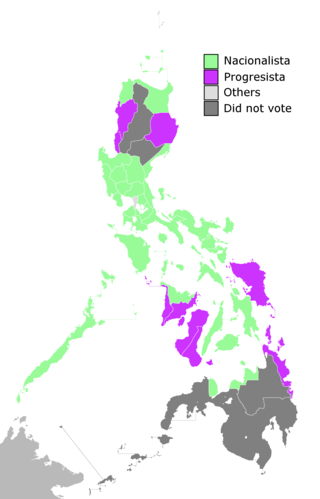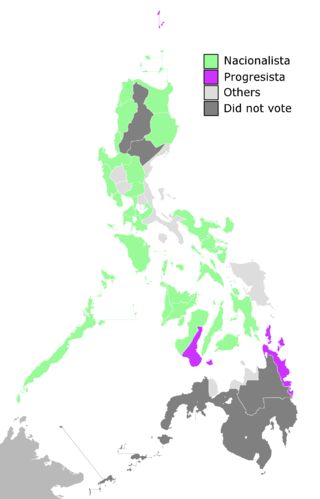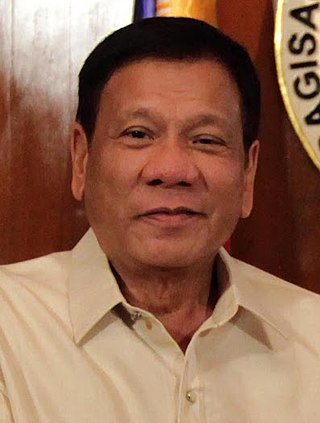
The Commonwealth of the Philippines was an unincorporated territory and commonwealth of the United States that existed from 1935 to 1946. It was established following the Tydings–McDuffie Act to replace the Insular Government of the Philippine Islands and was designed as a transitional administration in preparation for full Philippine independence. Its foreign affairs remained managed by the United States.

Manuel Luis Quezon y Molina, also known by his initials MLQ, was a Filipino lawyer, statesman, soldier, and politician who was president of the Commonwealth of the Philippines from 1935 until his death in 1944. He was the first Filipino to head a government of the entire Philippines and is considered the second president of the Philippines after Emilio Aguinaldo (1899–1901), whom Quezon defeated in the 1935 presidential election.

The Commission on Elections, abbreviated as COMELEC, is one of the three constitutional commissions of the Philippines. Its principal role is to enforce all laws and regulations relative to the conduct of elections in the Philippines.

The vice president of the Philippines is the second-highest official in the executive branch of the Philippine government and is the first in the presidential line of succession. The vice president is directly elected by the people and is one of only two nationally elected executive officials, the other being the president.

The Government of the Philippines has three interdependent branches: the legislative, executive, and judicial branches. The Philippines is governed as a unitary state under a presidential representative and democratic constitutional republic in which the president functions as both the head of state and the head of government of the country within a pluriform multi-party system.

The Philippine Assembly was the lower house of the Philippine Legislature from 1907 to 1916, when it was renamed the House of Representatives of the Philippines. The Philippine Assembly was the first national legislative body fully chosen by elections.

The legislative districts of Cavite are the representations of the province of Cavite in the various national and local legislatures of the Philippines. At present, the province is represented in the House of Representatives of the Philippines by its eight congressional districts, with the districts' representatives being elected every three years. The congressional districts are coextensive with the provincial board districts, where each district is allotted two seats in the Cavite Provincial Board, creating a total of sixteen elective seats in the legislature.
Local elections were held December 14, 1937 in the Philippines. All Philippine women were allowed to vote and elect among them into public offices. One of the famous examples is the election of Carmen Planas as Councilor of the City of Manila.

Philippine Assembly elections were held in the Philippines on November 2, 1909.

Philippine Assembly and local elections were held in the Philippines on June 4, 1912.
The Second National Assembly of the Philippines was the meeting of the legislature of the Commonwealth of the Philippines, from January 24, 1939 until December 16, 1941, during the fourth, fifth, and sixth years of Manuel L. Quezon's presidency.

Senatorial elections happened on June 2, 1925 in the Philippines under the Jones Law provisions.
Legislative elections happened on June 5, 1928, in the Philippines under the Jones Law provisions.
Legislative elections happened on June 2, 1931 in the Philippines under the Jones Law provisions.
Plebiscites were held on June 18, 1940 in the Philippines to ratify the following amendments to the Constitution: the extension of the tenure of the President and the Vice-President to four years with reelection for another term; the establishment of a bicameral Congress of the Philippines, with the Senate as the upper house and the House of Representatives as the lower house; and the creation of an independent Commission on Elections composed of three members to supervise all elections and plebiscites.

The 1995 Philippine general election were held on May 8, 1995. Filipinos protected the ballot boxes with their lives and campaigned against traditional politicians who used bribery, flying voters, violence, election rigging, stealing of ballot boxes, etc. The Philippine National Police (PNP) listed five people dead and more than 200 hotspots before and 300 hotspots during the election.

Presidential elections, legislative and local elections were held in the Philippines on May 11, 1998. In the presidential election, Vice President Joseph Estrada won a six-year term as president by a landslide victory. In the vice-presidential race, Senator Gloria Macapagal Arroyo won a six-year term as vice president also by a landslide victory. This was the third election where both president and vice president came from different parties.

A general election in the Philippines took place on May 9, 2016, for executive and legislative branches for all levels of government – national, provincial, and local, except for the barangay officials.

The 2019 Philippine general election was conducted on May 13, 2019. A midterm election, those elected therein will take office on June 30, 2019, midway through the term of President Rodrigo Duterte.

The 2022 Philippine general election took place on May 9, 2022, for the executive and legislative branches of government at every level – national, provincial, and local – except for the barangay officials.














